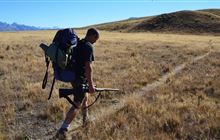Wapiti deer hunting
Introduction
Learn about wapiti, the largest round horned deer in the world.Description
Size: Wapiti (Cervus elaphus nelsoni) have a shoulder height of 1200 – 1500 mm with males weighing 300-450 kg and females at 200-270 kg.
Colour: Winter colour yellowish to brownish grey, underside blackish, head neck and legs dark chestnut brown. Rump patch large and uniform cream bordered with dark brown.
Summer body coat more tawny, reddish or light bay with dark legs.
Antlers: Carried by males only, grown and cast annually. Maximum size reached at about 7 years old.
Social behaviour: Feeding occurs early morning and late evening, eating a range of grasses, herbs, shrubs and other plant material (eg broadleaf, kamahi, silver beech, lancewood). Wapiti behaviour and habitat use is similar to red deer, which wapiti freely mix and breed with.
Reproduction: Rut begins in mid March to end of April. Males emit a whistle like bugle rather than the roar of a red deer.
Gestation period: 247 to 262 days.
Birthing: Most young are born between, late November and mid December.
Nomenclature: Male = bull. Female = cow. Young = calf.
Where to hunt
The Fiordland herd is the only free-range wapiti herd in the Southern Hemisphere.
Wapiti are distributed between Charles Sound, to the south of Fiordland; Sutherland to the north, on the Tasman Sea side of Fiordland; then across to the Doon River, which flows into the middle fiord of Lake Te Anau, down to the Worsley River to the north.
Fiordland Wapiti Foundation and DOC run a joint programme to manage the effects of wapiti. This has been very successful for both recreational hunters and the environment by controlling red deer, and lesser quality wapiti. Wapiti trophies have been improving each year.
However, with better quality animals on offer, more people are interested in hunting wapiti. This has put a huge strain on the herd. Many wapiti are now shot quite young – the average age of bulls being shot is only 3 years and 6 months.
Find a hunting block that has wapiti deer
You can use the hunting block search function to find hunting areas that have wapiti deer.
Search for a hunting block that has wapiti deer.
Tips for hunting wapiti
|
Characteristics/behaviour |
Hunting response |
|---|---|
|
Wapiti are large deer weighing up to 450 kg.
|
Hunters should use a flat trajectory calibre with high striking energy at 300 m. Suitable calibres are minimum .270. |
|
The wapiti start their rut a lot earlier than red deer, with bulls bugling as early as the second week of March – 2 weeks earlier than red deer. |
During the rut blocks are balloted so hunters need to be aware of when ballots are opened, conditions of entry etc. |
|
Fiordland has wet and changeable weather. Hunters who want to tackle the wapiti need to be fit and well prepared. |
Ensure your party is well briefed on the area to be hunted and members are fit enough for the terrain/conditions likely to be encountered. |
|
Wapiti like the open tops, slips and clearings. |
A good pair of binoculars will assist in glassing likely areas and planning a stalk to a sighted animal. |
|
Fiordland is starting to produce some very reasonable trophies with bulls pushing to the magic mark of 50 inches again. Even the young crop of animals is pushing the 40 inch mark. |
As part of herd management for trophy potential the Fiordland Wapiti Foundation are encouraging hunters to refrain from shooting young bulls. |
|
About 50% of the wapiti area is in the Glasinock Wilderness Area. The use of powered vehicles, boats or aircraft in wilderness areas is not permitted, so all access is by foot. |
Ensure your party is well briefed on the area to be hunted and members are fit enough for the terrain/conditions likely to be encountered. |
Wild Animal Recovery Operators (WARO) work in the area for most of the year, except for between the end of February and the end of April (the balloted hunting season). As part of their operation, there is an observer from the Fiordland Wapiti Foundation who decides what is to be shot.
Hunting seasons and ballots
In New Zealand, there is no seasonal restriction to hunting Wapiti, meaning generally they can be hunted throughout the year. There are however, instances where restrictions apply for specific reasons and periods when hunting is favoured.
Specific restrictions
Rut period closures
Hunting pressure is very high during the rut period. The area is closed from 31 December until end of April.
A ballot is held to allocate hunting blocks, which are divided up into four 10-day hunting periods.
Hunters can get current ballot information from the Fiordland Wapiti Foundation or from DOC in Te Anau or Invercargill.
Other temporary closures
Occasionally an area may be closed on a temporary basis to enable research or other management to be undertaken without being compromised by hunting.
Favoured hunting period
The bugle or rut is when the bulls are most vocal, calling to attract the attention of cows and are less cautious than other times. The bugle lasts from mid March to late April.
Spring is another favourable time of the year to hunt wapiti. During spring, wapiti move out of the forest to feed on new grass and shrub growth.
International travel with hunting trophies
You may need CITES documentation to enter or leave New Zealand with your hunting trophy.


